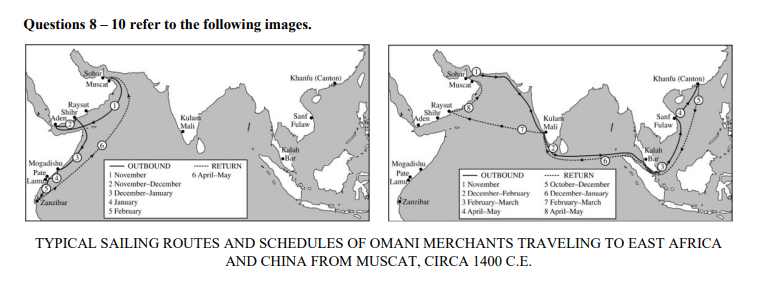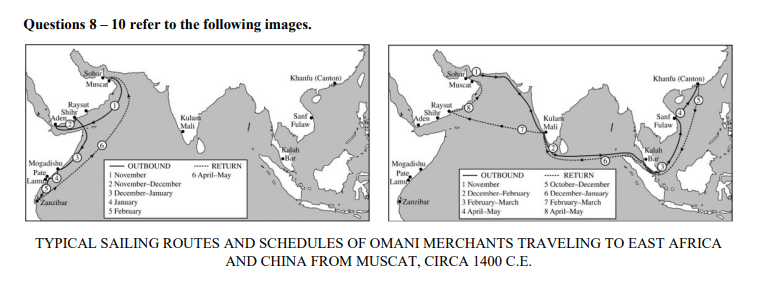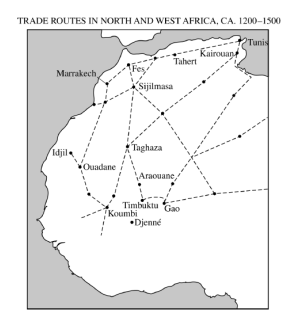Which of the following accurately describes the Mongol Empire’s role in facilitating transEurasian trade?
(A) It imposed Mongol religious beliefs and practices on conquered peoples
(B) It reestablished the Silk Roads between East Asia and Europe
(C) It created a self-contained economic system by banning non-Mongol merchants from its territories
(D) It developed a sophisticated bureaucracy staffed by talented Mongols
(B) It reestablished the Silk Roads between East Asia and Europe
Buddhism
A. The world’s oldest religion established in India over 4,000 years ago
B. The core beliefs and acts of Islam
C. A religion that was founded by Siddhartha Gautama in India in the 6th century b.c.e.
D. A state of enlightenment, meaning a person’s desires and suffering go away
E. A monotheistic religion that originated in the Mesopotamia region in the 7th century b.c.e.
C. A religion that was founded by Siddhartha Gautama in India in the 6th century b.c.e.
How many units do we have in this course?
10

The particular routes and timings of the voyages depicted on the maps best reflect which of the following characteristics of Omani merchants?
(A) Their Islamic ritual observances, which made travel difficult during the fasting period of Ramadan
(B) Their advanced knowledge of Indian Ocean currents and monsoon wind patterns
(C) Their need to avoid the routes traveled by the faster and better-armed Portuguese trading ships
(D) Their control of the sources of grain needed by Chinese and East African cities
(B) Their advanced knowledge of Indian Ocean currents and monsoon wind patterns
Caravan
A. Technology invented to allow camels to carry goods across the desert
B. Seasonal winds in the Indian Ocean that aided in voyages
C. Syncretic language blending African Bantu language and Arabic.
D. groups of merchants who travelled together on their camels
E. Small goods such as silk, porcelain, sugar, cotton etc.
F. Large goods such as gold, lumber, ivory, textiles, coffee etc.
D. groups of merchants who travelled together on their camels
True or false is Kipp Connect High School the best?
True

Based on the maps and your knowledge of world history, which of the following best describes the effect of the spread of Islam on Indian Ocean trade? (A) It led to the expansion and intensification of commerce along already existing trade routes
(B) It led to the disappearance of previously established trade networks
(C) It led to an expansion of land-based caravan trade but also to a decline of maritime trade
(D) It led to the first creation of trade links between previously isolated world regions
(A) It led to the expansion and intensification of commerce along already existing trade routes
Hinduism
A. The world’s oldest religion established in India over 4,000 years ago
B. The core beliefs and acts of Islam
C. A religion that was founded by Siddhartha Gautama in India in the 6th century b.c.e.
D. A state of enlightenment, meaning a person’s desires and suffering go away
E. A monotheistic religion that originated in the Mesopotamia region in the 7th century b.c.e.
A. The world’s oldest religion established in India over 4,000 years ago
 The spread of which of the following religious traditions was most directly facilitated by trade along the routes shown on the map?
The spread of which of the following religious traditions was most directly facilitated by trade along the routes shown on the map?
(A) Christianity (B) Buddhism (C) Islam (D) Judaism
(C) Islam
 Which of the following factors contributed the most to Omani traders’ ability to undertake the voyages depicted on the maps?
Which of the following factors contributed the most to Omani traders’ ability to undertake the voyages depicted on the maps?
(A) The strong backing for the voyages by the Caliphate
(B) Navigational and maritime innovations, such as the astrolabe and lateen sail
(C) The spread of Arabic as the language of commerce in the Red Sea and western Indian Ocean basins
(D) Innovations in agriculture, which allowed the Omani population to increase rapidly
(B) Navigational and maritime innovations, such as the astrolabe and lateen sail
Five Pillars
A. The world’s oldest religion established in India over 4,000 years ago
B. The core beliefs and acts of Islam
C. A religion that was founded by Siddhartha Gautama in India in the 6th century b.c.e.
D. A state of enlightenment, meaning a person’s desires and suffering go away
E. A monotheistic religion that originated in the Mesopotamia region in the 7th century b.c.e.
B. The core beliefs and acts of Islam
Where are Ms. Garcia's parents from?
Dad is from Mexico and Mom was from El Salvador
Emperor Zhengzong, being deeply concerned with agriculture, came to know that the Champa rice was drought resistant and that the green lentils of India were famous for their heavy yield and large seeds. Special envoys, bringing precious things, were dispatched with a view to securing these varieties.... When the first harvests were reaped in the autumn, the emperor called his closest ministers to taste them and compose poems for Champa rice and Indian green lentils.” Shu Wenying, Buddhist monk, China, eleventh century C.E.
. Which of the following made possible the
Chinese cultivation of the staple crops
described in the passage?
(A) The creation of new forms of governance in
China during the Song dynasty
(B) The intensification of regional trade
networks in East and South Asia
(C) The diffusion of Buddhism into China
(D) The creation of diasporic trade
communities along the Silk Road
(B) The intensification of regional trade
networks in East and South Asia
Nirvana
A. The world’s oldest religion established in India over 4,000 years ago
B. The core beliefs and acts of Islam
C. A religion that was founded by Siddhartha Gautama in India in the 6th century b.c.e.
D. A state of enlightenment, meaning a person’s desires and suffering go away
E. A monotheistic religion that originated in the Mesopotamia region in the 7th century b.c.e.
D. A state of enlightenment, meaning a person’s desires and suffering go away
Increased cross-cultural interactions is called what?
Cultural Diffusion